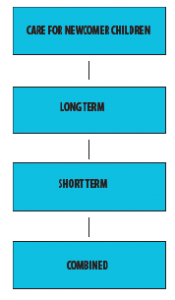CARE FOR NEWCOMER CHILDREN (CNC): THE MODEL
When a Service Providing Organization (SPO) is funded to provide care to newcomer children while parents participate in IRCC-funded services, it now falls under the Care for Newcomer Children (CNC) model.
The Model
Development of the CNC Model and Requirements was carried out from July 2009 through March 2010 by a team from CMAS and with advice from an Advisory Committee. The Committee included academics and representatives of stakeholder groups from across the country. CMAS conducted extensive consultations with the settlement community to collect data and carry out interviews electronically and in person through site visits, meetings, and conference participation.
The CNC model builds on features of the current LINC childminding and Occasional Child Care programs while extending them to create a single, comprehensive system for CNC delivery that integrates a wide range of programming options. The CNC model is designed to be flexible, to permit SPOs to care for more newcomer children in a variety of formats and settings, and to ensure CNC programs can be modernized and streamlined in tandem with new policy initiatives and changes in adult service delivery.
The newest elements of the CNC model were tested at two pilot sites during the 2011/12 contract year.
Goals
To support the delivery of settlement services by making it possible for SPOs in all provinces to offer safe and healthy CNC programs within a comprehensive and flexible system; to meet the needs of parents; and provide effective and efficient standards that manage risks and support newcomer child development.
To move towards more efficient allocation of resources to ensure better uptake of settlement services while controlling costs.
Types of Care
Three basic types of care are being adopted: Long Term, Short Term and Combined. These types of care could be offered individually or in combination. This would depend on client needs in relation to settlement programs, SPO capacity, and IRCC approval.
Long Term Care is defined as “care that is provided on a regular basis to the same group of children.” It will be chosen by SPOs offering regular, ongoing programs such as Language Instruction (LINC).
EXAMPLE: Jorge is managing a site that primarily offers language classes and offers them during the day, evenings and weekends. For his clients attending the CIC-funded language classes, they are all eligible for CNC and so Jorge chooses to implement a Long Term care program. The same children are there with their parents, every day, for the duration of the session. He does not offer many Short Term workshops or events outside of LINC or ELT and does not have the client demand for them.
Short Term Care is defined as “care that is provided on an irregular, occasional basis to children who are usually different each time care is offered.” It will be chosen when care for an individual child is needed on an irregular, occasional basis by SPOs offering settlement services.
EXAMPLE: Ursula has a very small but diverse centre for newcomers. Her organization offers many short-term workshops, information sessions, and events. Many of their clients are parents of young children. Ursula decides to offer Short Term care. For Ursula’s organization,there is no need for Long Term care because children will only be staying for a few hours or a few days. Her boardroom can be easily modified to accommodate the needs of the children, and she has sufficient room in an adjacent storage room for all required toys and equipment.
Combined Care gives SPOs the opportunity to mix children and is defined as “care for children who attend on a daily basis as well as children who attend on an irregular basis.” This care is offered in the same space at the same time.
EXAMPLE: Jenna’s organization offers settlement services and full-time language classes. From time to time, she offers information sessions and the parents require care for their children during these sessions. Since Jenna offers few information sessions and does not have the additional space for a separate CNC program, Jenna decides to offer Combined care. She has a large enough space, and with careful scheduling for staffing and activities, she has the Short Term children join the children attending Long Term. She now can offer one childcare program for all, regardless of the CIC-funded service or how long the children will stay in care.
Benefits
The CNC model allows SPOs the flexibility to develop their CNC program based on specific organizational needs and resources available. It reduces barriers, allowing you to meet the needs of newcomer families and achieve your organizational goals. The CNC model allows you to:
1. Effectively meet the needs of your clients.
2. Support the distinctive settlement needs of newcomer families through improved programming.

